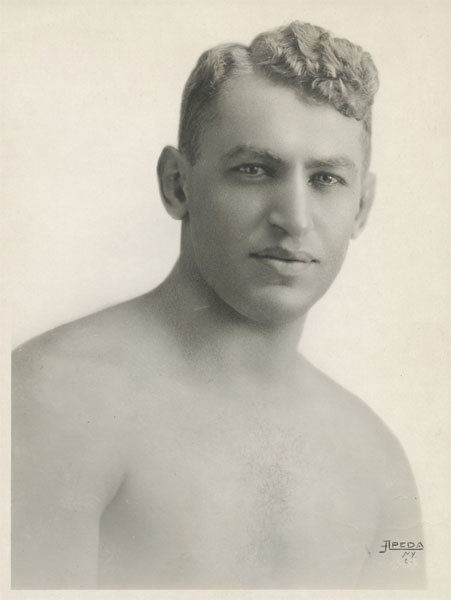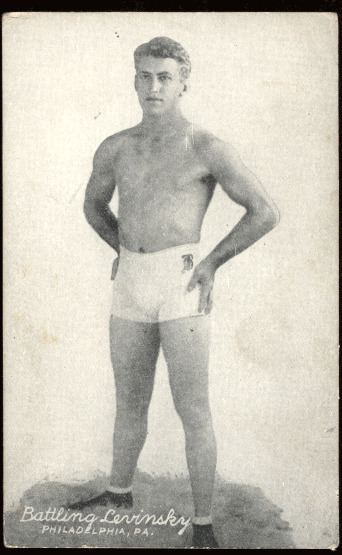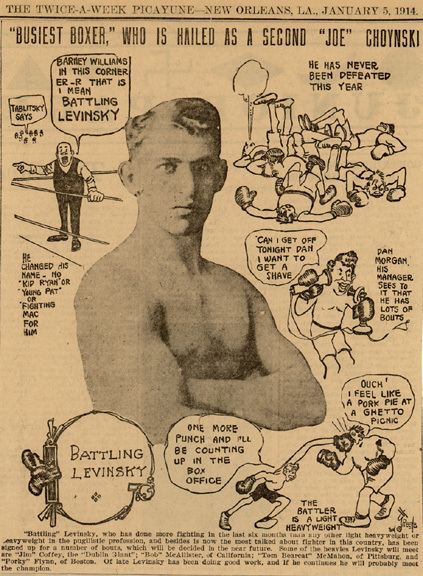Real name Barney Lebrowitz Wins 196 Martial art Boxing Rated at Light Heavyweight Wins by KO 30 Division Light heavyweight | Reach 70 in (178 cm) Name Battling Levinsky Total fights 287 Nationality American Height 1.8 m | |
 | ||
Born June 10, 1891Philadelphia, Pennsylvania ( 1891-06-10 ) Died February 12, 1949, Philadelphia, Pennsylvania, United States | ||
Barney Lebrowitz (June 10, 1891 – February 12, 1949), better known as Battling Levinsky, was the world light heavyweight champion from 1916 to 1920. Statistical boxing website BoxRec lists Levinsky as the #12 ranked light heavyweight of all-time, while The Ring Magazine founder Nat Fleischer placed him at #9. The International Boxing Research Organization rates Levinsky as the 20th best light heavyweight ever. He was inducted into the Ring Magazine Hall of Fame in 1966, the International Jewish Sports Hall of Fame 1982, and the International Boxing Hall of Fame in 2000.
Contents
- Early life
- Career beginnings
- World light heavyweight champion
- Career record
- Retirement from boxing and personal life
- References

Early life

Born in Philadelphia on June 10, 1891 of Jewish immigrant parents from Russia, he shined shoes and sold newspapers after school to contribute to his family. In his earliest boxing days, he sold jewelry during the day, but boxed in the evening at the clubs in Philadelphia, probably to hide his fledgling boxing career from his parents.
Career beginnings

Battling Levinsky began his boxing career under the name Barney Williams. However, he received little attention until he took on a manager named “Dumb” Dan Morgan in 1913, who changed Barney’s name along with his boxing fortunes. He was known for possessing incredible defensive skills, providing few knockouts but often leaving the ring at the end of a fight without having received a truly damaging blow.

Morgan came up with his name of "Battling Levinsky" to obscure the fact that Barney's boxing style was actually more defensive than aggressive in order to give his opposition the impression that he was an aggressive puncher.

Levinksy first entered the pro ranks as Barney Williams around 1906, and many of his fights between 1906 and 1910 when he became "Battling Levinsky" were not recorded by boxing publications, particularly Nat Fleischer's Ring Record Book. He did not officially become "Battling Levinsky" until 1913. In his first 100 fights between 1910 and 1914, he lost only three of his bouts.
Between 1914 and 1918, Levinsky fought 127 times, averaging an impressive 37 fights a year, even for his era. Levinsky fought 37 times in 1914 — 9 times in the month of January alone. In January 1915, he began the year with two 10-round bouts on New Year’s Day — 1 each in Brooklyn, New York City and 12 round bout in Waterbury, Connecticut.
World light heavyweight champion
After two title-match losses to world light heavyweight champion Jack Dillon, (April 1914 and April 1916), Levinsky wrested the crown from Dillon on October 24, 1916. Fifty-nine bouts later, almost four years to the day, he lost his championship to France’s enormously popular Georges Carpentier. Though not unique for his boxing era, Levinsky fought many of his opponents multiple times. According to historian Ken Blady, Levinsky fought Dillon a total of ten times in his career. Perhaps his worthiest opponent, Nat Fleischer once rated Dillon the third greatest Light Heavyweight of all time while boxing promoter Charley Rose placed him at #2. Levinsky met "Fireman Jim Flynn," the only man to ever knock out Jack Dempsey, and heavyweight "Porky" Flynn a total of nine times.
Career record
In an era when the winners of bouts could not be decided by the votes of referees and boxing judges, and titles changed hands only in the case of a knockout, Levinsky fought all comers, including losses to future heavyweight champions Gene Tunney and Jack Dempsey. He also fought the 1923 World Middleweight Champion Harry Greb at least three times between 1918 and 1919, successfully defending his Light Heavyweight title in each meeting. Levinsky loved to fight, although his claim to having fought close to 500 bouts has not been substantiated.
His official professional record: 287 bouts – won 196 (30 KOs), lost 54, drew 37.
In his early career, Levinsky was managed by Fred Douglas (1910–11) and Jack Hanlon (1911–13). Al Lippe managed him in his comeback, from 1926–1929.
Retirement from boxing and personal life
After his loss to Gene Tunney on January 13, 1922, Levinsky attempted to retire from boxing and entered the Real Estate business. Around 1926, He returned to the ring as a heavyweight after a series of financial losses and faced Tommy Madden, beginning his four-year comeback. He fought around forty-two times in his comeback, losing only twelve matches. After losing badly to Herman Weiner on January 15, 1929, he seriously discussed retirement before boxing one more time the following year on October 1930 in New York, beating Joe Simms in three rounds.
Levinsky's son Stanley was killed in the Battle of the Bulge, WWII. His daughter Harriet, a graduate of West Philadelphia High School, currently resides in Lancaster, PA. Levinsky's grandchildren are Stanley Solodky, Barry Solodky, and Susan Oldham.
Levinsky died on February 12, 1949 in Philadelphia, Pennsylvania at only 57.
He was inducted into the Boxing Hall of Fame in 1966, and is in both the Pennsylvania Hall of Fame and Jewish Sports Hall of Fame in Israel.
